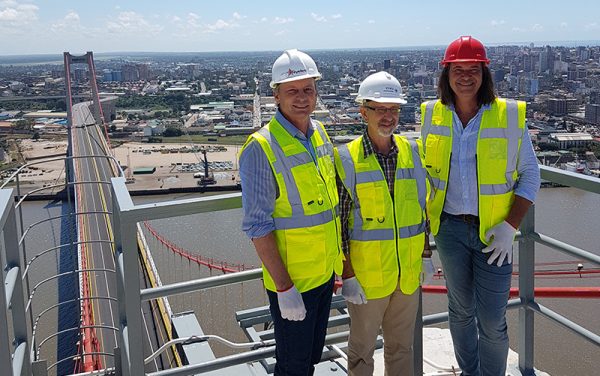ATOP AFRICA’S LONGEST SUSPENSION BRIDGE
Emeritus Professor Mark Alexander had always wanted to stand on top of a suspension bridge, just to soak in the combined forces of nature and structural engineering.
On 8 March 2019 he fulfilled that wish at the summit of a 145 m-high concrete pylon, looking out over Maputo harbour from the heights of Africa’s longest suspension bridge, the R11.3 billion Maputo-Katembe Bridge. Officially opened in November 2018, the bridge and approach stretch for 3km, with a main span of 680 m, the main deck hovering 20 m above the water to allow major shipping into the harbour.
Alexander, from the University of Cape Townʼs (UCT) Department of Civil Engineering, was hosted by the bridge’s team of China Road and Bridge Corporation, a Chinese parastatal of design and construction engineers, as well as the German quality controllers GAUFF Engineers.
He was there as president of the Concrete Society of Southern Africa, and as a judge in the society’s biennial Fulton Awards for the subcontinent’s top concrete projects in a range of categories.
As such, Alexander got to walk all over the bridge, examining the foundations, the finishes, the massive cable anchorages and the aesthetics.
“We judged it on a lot of criteria: local labour use and practices, health and safety, attention to sustainability issues as well as the technical design and use of materials.”
He was pleased by what he saw.
“There are about 8000 individual steel strands in those cables, with 91 tendons in each cable. And each tendon has about 90 steel strands. They’re massive, some 75cm in diameter. I couldn’t wrap my arms around one.”
Regarded as a prestige project for Mozambique, the tolled bridge connects the two sides of Maputo Bay and shaves hours off travel time to the South African border.
However, It’s hardly trafficked s because the area south of Maputo Bay is very undeveloped. The idea is that this bridge will open the entire area for development.
The design and construction team faced some formidable challenges, evident in the massive foundations, built to cope with the soft, loose alluvial soils at the mouth of Maputo harbour.
“They’ve had to go down to tremendous depths to found these pylons, and even deeper with the piles. But if you think of the cable forces that come over the pylons and down, and they have to be anchored back to the earth, in the absence of sound rock or other stable strata in which to found these cables.”
The solution was to cast cable anchorage caissons, acting as a counterweight to which these cables are fixed, essentially held there by gravity, just by the weight of these huge concrete and soil-filled caissons.
“In that regard it’s remarkable; quite a unique bridge as most suspension bridges don’t have to be founded under these conditions. I think it’s a signature project to show that this kind of structure can be built in Africa, albeit by Chinese contractors, and it does set a benchmark for what can be accomplished,” Alexander explained.
The construction company were also careful to produce a “sustainable” and durable concrete by using a considerable amount of fly ash in the mix. Fly ash is a by-product of electricity production from coal-fired power stations; a waste product that’s beneficial in concrete for producing long-term, durable structures.
“Fly ash also reduces the amount of cement that goes into the concrete, shrinking the carbon footprint and the environmental impact of the materials,” he said.
GAUFF Engineering were retained by the Mozambican government to provide quality assurance and here UCT played a vital role. Working with Alexander’s colleague, Professor Hans Beushausen, they implemented the South African suite of durability index testing for the concrete. This was developed by UCT and the University of the Witwatersrand as a joint endeavour, but was essentially rolled out from the UCT laboratory during the past 20 years, largely the work of UCT’s Concrete Materials and Structural Integrity Research Unit (CoMSIRU).
These tests have become South African National Standards (SANS), and are now used worldwide.
The results showed that the bridge concretes were of a high quality, “the right stuff for the job”.https://www.news.uct.ac.za/article/-2019-05-06-atop-africas-longest-suspension-bridge






